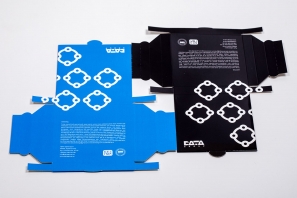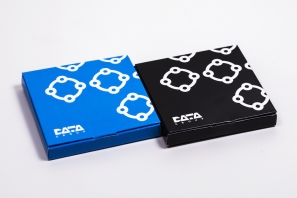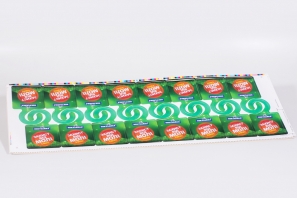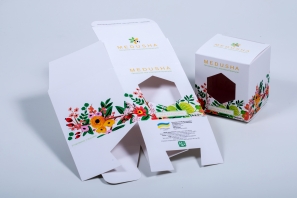Die-cutting cardboard
Any printed products undergo post-printing finishing and die-cutting is one of post-printing techniques which involves die cutting tools (plates with steel pre-shaped blades) to cut out desired windows, shapes, and outlines of a prospective product.
All products are made to order.
 More examples
Hide
More examples
Hide

Die-cutting allows to carry out complex operations even inside the packaging which is very important for production of packaging with irregular configuration. Die-cutting is frequently used for manufacturing of designer printed products (envelopes, greeting cards, labels, cardboard packaging and the like). Die-cutting provides extremely crisp, smooth edges, ready for gluing or insertion of other material.
How does the die cutting process work?
Cutouts and contours on sheets of cardboard – a small detail that can transform any product. Cardboard die-cutting using die-cutting tools proceeds as follows:
- development of the layout and its subsequent approval;
- creating a mold;
- preparing a cardboard sheet.
Final stage – the cutting process itself. The die under pressure cuts out the desired shapes and contours. Die cutting is a preparatory step for the final stage - folding. Printing and additional processing - lamination, foiling, embossing and other types of finishing are applied to cardboard sheets before die cutting.
For which products is stamping relevant?
Die-cutting in printing is relevant for creating various printing and packaging materials, including:
- packaging – boxes, gift bags, labels;
- postcards – invitations or other handouts for events or congratulations;
- educational products – exercise equipment, puzzles, tasks for early development, preschool preparation or school education;
- promotional materials – business cards, brochures, souvenirs.
Punching technology opens up many possibilities for designers and manufacturers, allowing them to create unique and creative products.
Types of cutting depending on material
Die cutting is used in a variety of industries, including printing, packaging, textiles and many others. Die-cutting of packaging, as well as other printing materials, can be done in the following ways:
- Internal. Cutouts or holes of different shapes and sizes inside the material according to the design. This ensures precision and accuracy of actions.
- External. Punching allows you to cut a specified pattern along the edge on paper, cardboard or plastic.
This technology will be relevant in the production of business cards, labels, leaflets and booklets, children's literature, cardboard packaging, interior parts and many other product categories.
Advantages of cardboard die-cutting
The use of molds in the design of cardboard products is in demand due to the advantages that such design offers:
- Personalization. Rectangular, square or round die cuts allow you to add unique, custom design elements – logo, image, text or shaped details.
- Original forms. Traditional printed products are being replaced by non-standard products that instantly attract glances and attention.
- Increased functionality. Die-cutting makes it easy to create internal compartments in a box or make a card with multiple inserts, thereby increasing the appeal of the finished product to a specific user.
Die-cutting boxes, as well as other printed materials – a great way to improve brand perception, as well as to stand out among competitors, which will have a positive impact on sales growth and will fully cover all design costs.
Product punching can be internal for through holes or external for trimming the edges of printed products. Postpress operation is often required in the production of business cards, tickets, labels, postcards, children's books, cartons box, and custom envelopes.
What types of cardboard die-cutting does ATTOLIS offer?
Where is paper and cardboard die-cutting used?






















